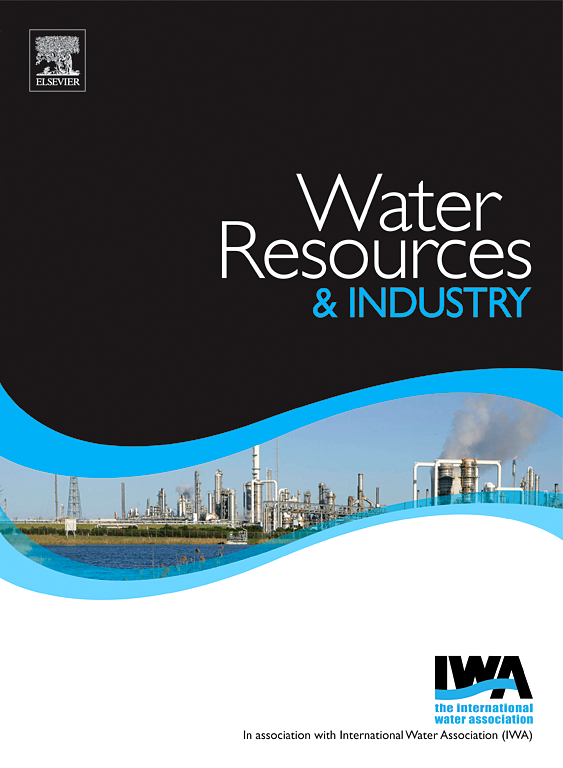四种膜基处理炸药生产废水的性能比较
IF 7.5
3区 工程技术
Q1 WATER RESOURCES
引用次数: 0
摘要
本研究评估了超滤(UF)、纳滤(NF)、反渗透(RO)、离子交换(IonEx)和固定床过滤(FBF)等不同配置处理爆炸生产废水的性能。实验在实验室规模的死端膜装置和离子交换和固定床过滤装置上进行。通过理化分析(COD、TOC、Pb (II)、Na、NO3 -N、pH、电导率),以及膜透性监测和费氏弧菌和小Lemna的生态毒性试验,评价了4种处理方案的性能。UF-NF-RO系统对污染物的去除效果显著,COD、TOC、Pb(II)和Na分别降低88.6%、63.3%、99.6%和91.1%。然而,尽管废水截留度很高,但仍未达到排放标准。UF-RO-RO配置采用了更紧密的超滤膜和两个反渗透级,实现了更好的污染物去除,但仍不符合法规要求。UF-RO-AnEx系统对铅和钠的去除率较高,但最终出水COD、TOC和NO3-N的浓度均高于允制值。最有效的配置是FBF-IonEx-RO,在离子交换和RO之前,使用砂、高岭土粘土和活性炭进行固定床过滤。该方法几乎完全去除了Pb (II)和NO3-N,同时显著降低了COD和TOC浓度,最终达到排放标准。膜透性分析表明,高导电性引起的结垢对反渗透污染的影响大于有机物。使用小莱姆纳和费氏弧菌进行的生态毒性测试证实,FBF-IonEx-RO配置产生的废水毒性最小,表明其作为一种有效的废水处理方案的潜力。本文章由计算机程序翻译,如有差异,请以英文原文为准。
Comparative performance of four membrane-based treatment strategies for wastewater from explosives production
This study evaluates the performance of various configurations that involve ultrafiltration (UF), nanofiltration (NF), reverse osmosis (RO), ion exchange (IonEx), and fixed-bed filtration (FBF) for the treatment of wastewater from explosive production. The experiments were performed on a laboratory-scale dead-end membrane setup and ion exchange and fixed-bed filtration units. The performance of four treatment configurations was evaluated based on physicochemical analyses (COD, TOC, Pb (II), Na, NO3 -N, pH, conductivity) and supported by membrane permeability monitoring and ecotoxicity tests with Vibrio fischeri and Lemna minor. The UF-NF-RO system demonstrated significant removal of pollutants, with COD, TOC, Pb(II), and Na reductions of 88.6 %, 63.3 %, 99.6 % and 91.1 %, respectively. However, despite of the high retention degrees, the effluent did not meet discharge standards. The UF-RO-RO configuration, which utilized a tighter UF membrane followed by two RO stages, achieved improved pollutant removal, but remained insufficient for regulatory compliance. The UF-RO-AnEx system showed high lead and sodium removal, but in the final effluent concentration of COD, TOC, and NO3–N were above the allowed limits. The most effective configuration, FBF-IonEx-RO, employed fixed-bed filtration with sand, halloysite clay, and activated carbon before ion exchange and RO. This approach resulted in the nearly complete removal of Pb (II) and NO3–N while significantly reducing COD and TOC concentrations, ultimately meeting discharge standards. Membrane permeability analysis revealed that scaling due to high conductivity had a greater impact on RO fouling than organic matter. Ecotoxicity tests using Lemna minor and Vibrio fischeri confirmed that the FBF-IonEx-RO configuration produced the least toxic effluent, demonstrating its potential as an effective wastewater treatment solution.
求助全文
通过发布文献求助,成功后即可免费获取论文全文。
去求助
来源期刊

Water Resources and Industry
Social Sciences-Geography, Planning and Development
CiteScore
8.10
自引率
5.90%
发文量
23
审稿时长
75 days
期刊介绍:
Water Resources and Industry moves research to innovation by focusing on the role industry plays in the exploitation, management and treatment of water resources. Different industries use radically different water resources in their production processes, while they produce, treat and dispose a wide variety of wastewater qualities. Depending on the geographical location of the facilities, the impact on the local resources will vary, pre-empting the applicability of one single approach. The aims and scope of the journal include: -Industrial water footprint assessment - an evaluation of tools and methodologies -What constitutes good corporate governance and policy and how to evaluate water-related risk -What constitutes good stakeholder collaboration and engagement -New technologies enabling companies to better manage water resources -Integration of water and energy and of water treatment and production processes in industry
 求助内容:
求助内容: 应助结果提醒方式:
应助结果提醒方式:


